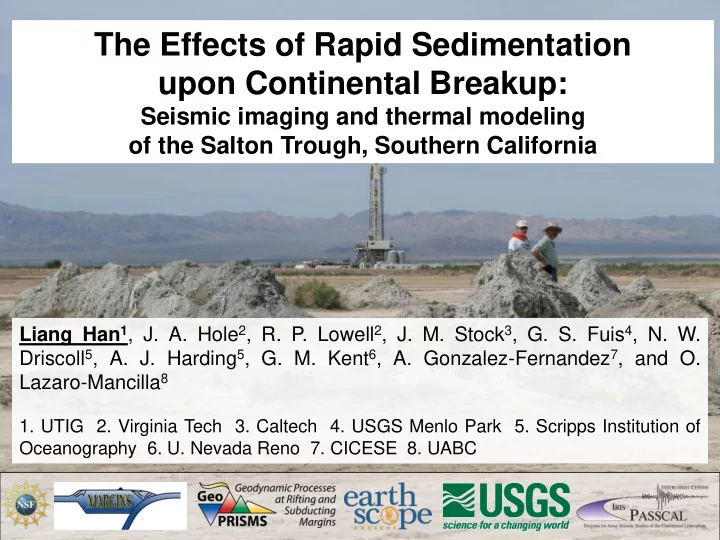

The Effects of Rapid Sedimentation upon Continental Breakup: Seismic imaging and thermal modeling of the Salton Trough, Southern California Liang Han 1 , J. A. Hole 2 , R. P. Lowell 2 , J. M. Stock 3 , G. S. Fuis 4 , N. W. Driscoll 5 , A. J. Harding 5 , G. M. Kent 6 , A. Gonzalez-Fernandez 7 , and O. Lazaro-Mancilla 8 1. UTIG 2. Virginia Tech 3. Caltech 4. USGS Menlo Park 5. Scripps Institution of Oceanography 6. U. Nevada Reno 7. CICESE 8. UABC 1
Gulf of California Extensional Province USA Mexico • Same amount of extension along the whole gulf since 6 Ma • North Colorado river delta No seafloor spreading • South No sediment East Pacific Rise Seafloor spreading 2
Gulf of California Extensional Province Salton Trough Question: How rapid sedimentation affects rifting processes • Same amount of extension along the whole gulf since 6 Ma • North Colorado river delta No seafloor spreading • South No sediment Seafloor spreading 3
Active Rifting in the Salton Trough 4
Active Rifting in the Salton Trough Brawley Seismic Zone (Shearer et al., 2005) 5
Active Rifting in the Salton Trough Brawley Seismic Zone (Shearer et al., 2005) Average heat flow = 125 mW/m 2 (Han et al., G3, 2016) 6
Salton Seismic Imaging Project 240 km long 36 shots and 38 OBS’s Receivers every 100-200 m 7 (Han et al., JGR, 2016)
Shot Gather Example (Han et al., JGR, 2016) 8
Imperial Valley Upper Crust (Han et al., G3, 2016) • Velocity smoothly increases with depth • No sharp boundary between sediment and crystalline rock 9
Imperial Valley Upper Crust • Velocity gradient decreases sharply at ~3 km depth across the valley 10
Metamorphism of Sediment (Han et al., G3, 2016) • Upper crust is metamorphosed young sediment by heat and fluid • Velocity gradient decreases where rock porosity is 5-10% 11
Whole Crust Velocity Model ~17.5 km 6.8 km/s 7.8-7.9 km/s ~100 km (Han et al., JGR, 2016) • lower crust gabbros by underplating • upper mantle hot 12
(Han et al., JGR, 2016) Old continental lithosphere has almost rifted apart, but no seafloor spreading; ~100 km wide new crust has been created by sedimentation and magmatism in last 2-4 Myr; 13
Thermal model • Uniformly extension • Sedimentation and magmatism compensate the crust thinning 14 • Heat transfer = conduction + advection
Initial time = 0 2.6 cm/yr 27 km Old crust 17 km (Han et al., in prep) • Sedimentation + magmatism maintains crust thickness • Modeled temperature consistent with observed heat flow 15
Temperature and Rheology (Han et al., in prep) • Earthquakes, volcanic activity and heat flow localized brittle deformation in the upper crust (in meta-sediment) • 1D lower crust, Moho and upper mantle distributed ductile deformation in the lower crust 16
The Effects of Rapid Sedimentation upon Continental Breakup • North American continental lithosphere has almost rifted apart, but no seafloor spreading • New crust (~100 km wide) has been created by sedimentation, metamorphism and magmatism future continental margin • Rapid sedimentation keeps crust thick and ductile delays continental breakup and initiation of seafloor spreading 17
Sedimentation & Continental Rifting Late-stage rifts: - rivers flow into them (if sediment > 4 km) - high heat flow Metamorphism of sediment probably a common, under-recognized process builds new felsic continental-margin crust delays final breakup and seafloor spreading 18
Recommend
More recommend